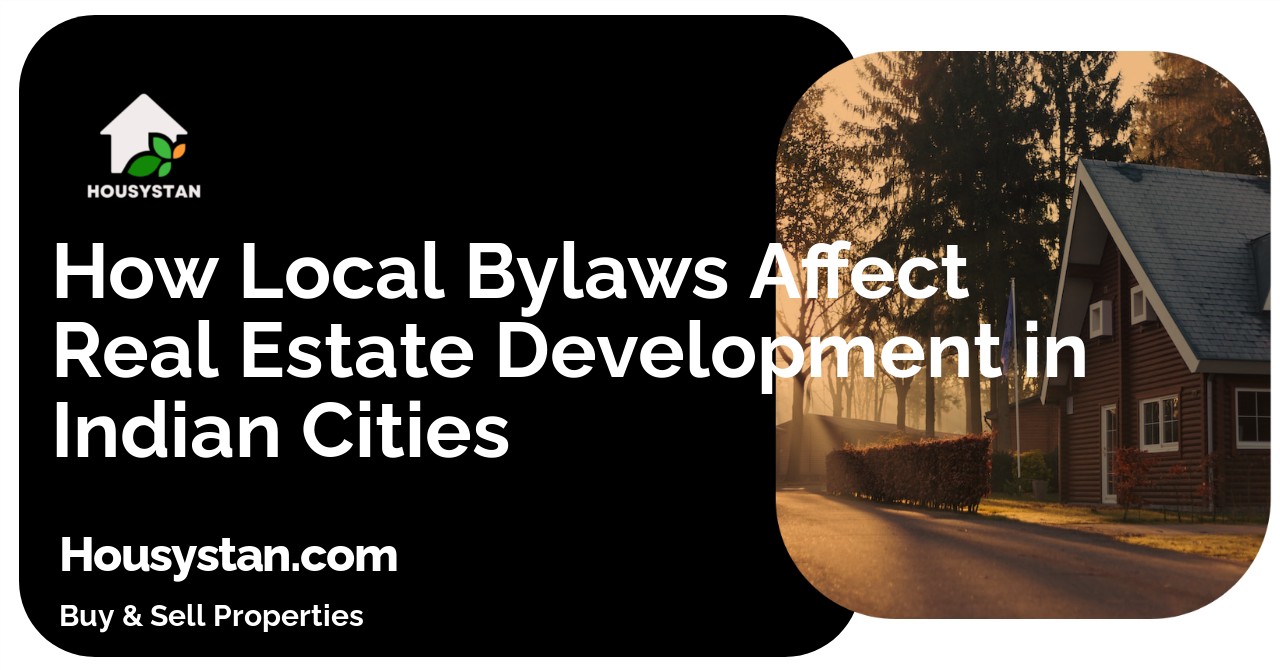How Local Bylaws Affect Real Estate Development in Indian Cities
Read latest blogs and articles from Housystan

The Information mentioned here was last updated on:
4/12/2025How Local Bylaws Affect Real Estate Development in Indian Cities
Real estate development in India is a dynamic industry influenced by various factors, including government regulations and local bylaws. For developers, understanding these bylaws is crucial as they significantly shape the construction and design of new projects. This blog post will delve into the key aspects of local bylaws and their impact on real estate development in Indian cities, making it easier for developers, investors, and homebuyers to navigate the landscape effectively.
The Role of Local Bylaws in Real Estate
- Verified Tenants/Buyers
- Unlimited Property Listing
- Zero subscription/charges fee
Bylaws are local regulations established by municipal authorities that oversee the planning, development, and construction within a city or town. These rules ensure the orderly development of urban areas, balancing growth with sustainability and community welfare. Here's how they impact real estate:
1. Zoning Regulations: Bylaws dictate how land within the city can be used, separating areas into residential, commercial, industrial, and agricultural zones. This zoning helps prevent conflicts between differing land uses and supports organized development.
2. Building Codes: These codes set standards for construction, ensuring buildings are safe and sustainable. They stipulate requirements such as structural design, energy efficiency, fire safety, and accessibility.
3. Density Controls: Bylaws determine how densely an area can be developed, influencing the height of buildings and the number of units allowed per plot. This is crucial for maintaining the character of neighborhoods and managing infrastructure demands.
4. Environmental Regulations: Measures are in place to protect natural resources and ensure sustainable development. Regulations may cover aspects like green building standards, waste management, and conservation of water and energy.
Key Aspects of Bylaws Affecting Development
Zoning and Land Use
Zoning laws dictate the specific use of land and can significantly influence real estate development strategies. For instance:
- Residential Zones: These are primarily for housing developments. Bylaws here ensure that the infrastructure, utilities, and services such as schools and parks are adequately planned to accommodate the population.
- Commercial Zones: These areas are earmarked for business activities. Developers must adhere to bylaws that regulate parking, signage, and business operations to maintain order and accessibility.
- Mixed-Use Zones: Increasingly popular in urban planning, these zones allow for a combination of residential, commercial, and sometimes industrial uses. They support vibrant community life and reduce the need for long commutes.
Building and Density Regulations
Bylaws also affect how buildings are constructed and the form they take:
- Height Restrictions: Bylaws may cap the height of buildings to preserve historic skylines or reduce shadows cast on neighboring properties. Height restrictions often vary depending on the proximity to airports, historical sites, or natural landscapes.
- Floor Area Ratio (FAR): This is a crucial metric that determines the total building floor area allowed relative to the size of the plot. A higher FAR can mean taller buildings or more units, influencing urban density and the skyline.
- Setback Lines: These define the distance a building must be from the property line, road, or another structure. Setbacks ensure developments do not encroach on public spaces and help maintain open areas for community use.
Environmental and Sustainability Considerations
With growing awareness of environmental sustainability, bylaws in many Indian cities now reflect green building practices:
- Energy Efficiency Standards: Developers might need to use specific materials or technologies that enhance energy conservation in buildings, reflecting global trends towards sustainability.
- Rainwater Harvesting: In many cities, bylaws mandate the inclusion of rainwater harvesting systems in new developments to address water scarcity and support sustainable water use.
- Waste Management: Proper disposal and recycling of construction and operational waste are critical components of modern bylaws, promoting eco-friendly practices within the industry.
Navigating Bylaws for Successful Development
For real estate developers in Indian cities, understanding and complying with local bylaws is essential for successful project execution. Here's how developers can navigate this complex landscape:
- Consult with Local Authorities: Engaging with municipal bodies during the planning phase can clarify compliance requirements and help avoid costly delays.
- Work with Experts: Hiring legal advisors and planners familiar with bylaw intricacies can streamline the development process and ensure all regulatory aspects are covered.
- Community Engagement: Understanding the needs and concerns of local communities can help developers align projects with community goals and secure public support.
Adapting to Changing Regulations
Urban areas are dynamic, and so are the rules governing them. Developers must stay informed about bylaw changes and adapt their strategies accordingly. Important considerations include:
- Periodic Revisions: Bylaws are subject to revisions as cities grow and evolve. Developers should regularly review updates to avoid potential non-compliance.
- Incorporating Future Trends: Trends such as smart cities, increased emphasis on public transport, and digitalization might influence future bylaw changes. Building flexibility into projects can accommodate such shifts.
- Networking with Peers: Engaging with industry groups and attending seminars can provide insights into regulatory trends and facilitate knowledge sharing among peers.
Understanding and adhering to local bylaws is an integral part of the real estate development process in India. These regulations are designed to guide sustainable and orderly urban growth, supporting the long-term prosperity of cities. Developers, investors, and homebuyers alike benefit from this reliable framework, fostering developments that meet regulatory standards and cater to the needs of urban populations.
For those looking to delve deeper into real estate specifics, city planning departments and legal resources are valuable references, offering detailed guidance on navigating the regulatory landscape.
This blog post aims to provide clarity on how local bylaws intersect with development plans, equipping stakeholders with the information needed to make informed decisions in this ever-evolving landscape.